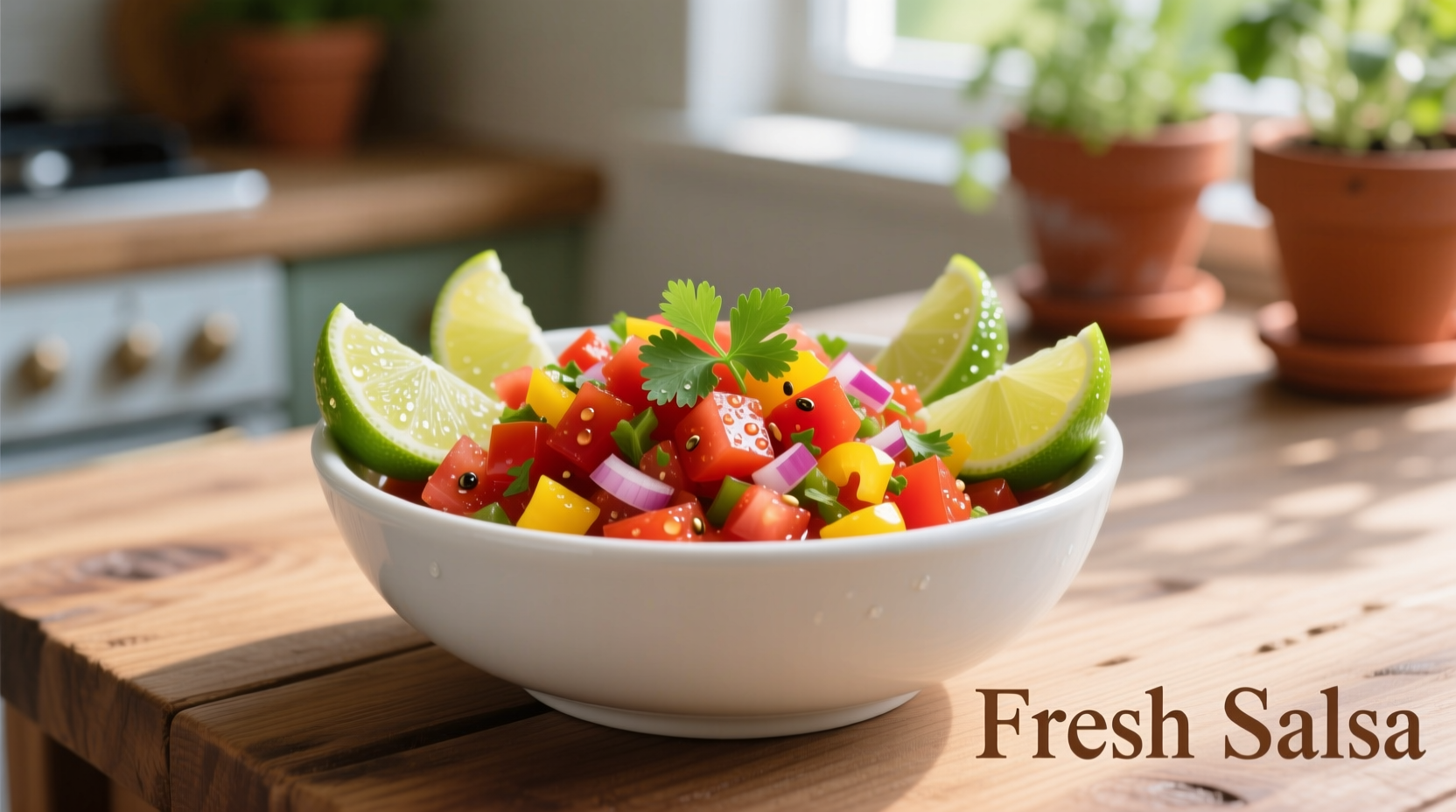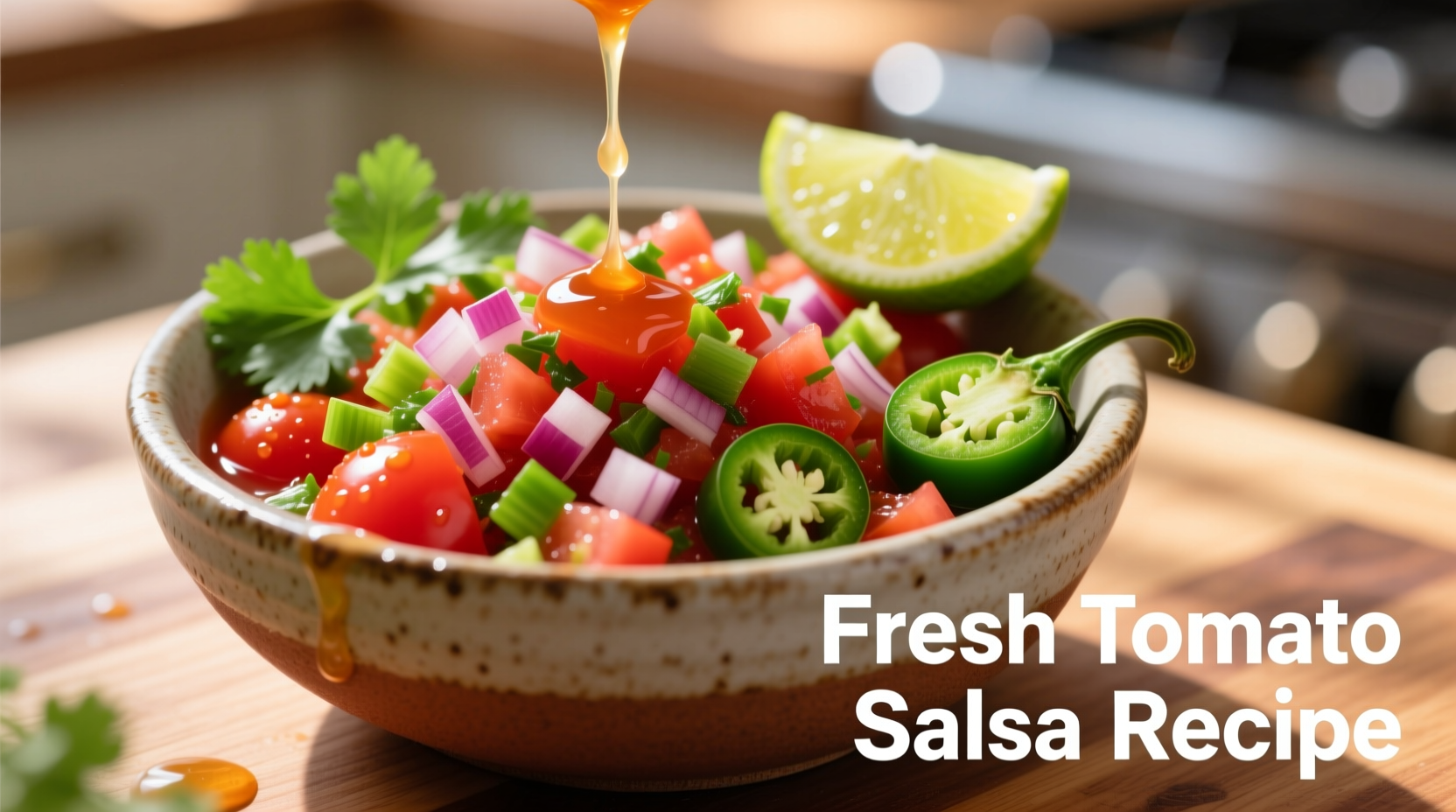There's nothing quite like the bright, vibrant flavor of homemade tomato salsa made with freshly picked tomatoes. Unlike store-bought versions packed with preservatives, fresh tomato salsa celebrates summer's bounty with crisp textures and garden-fresh flavors that elevate any meal. As Maya Gonzalez, our Latin American cuisine specialist with over a decade of research into indigenous spice traditions, explains: "Authentic fresh salsa connects you to centuries of Mexican culinary heritage where tomatoes originated."
Why Fresh Tomatoes Transform Your Salsa
Commercial salsas often use canned tomatoes for consistency, but fresh tomatoes provide superior flavor complexity and texture. When tomatoes ripen on the vine, they develop higher sugar content and more balanced acidity—critical for that perfect sweet-tart salsa profile. According to USDA agricultural research, vine-ripened tomatoes contain up to 30% more lycopene and volatile compounds that create distinctive aroma.
Selecting the Perfect Tomatoes
Not all tomatoes work equally well in fresh salsa. The ideal varieties balance juiciness with firm flesh that holds its shape after chopping. Avoid overly watery types that dilute your salsa's flavor.
| Tomato Variety | Flavor Profile | Best For Salsa Type | Texture After Chopping |
|---|---|---|---|
| Roma | Earthy, less acidic | Traditional chunky salsa | Holds shape well |
| Cherry | Sweet, concentrated | Fruit-infused variations | Maintains integrity |
| Beefsteak | Balanced sweet-tart | Restaurant-style salsa | Slightly softer |
| Heirloom | Complex, floral notes | Gourmet presentations | Varies by variety |
Pro Tip: For optimal flavor development, select tomatoes that are fully colored but still firm to the touch. Slightly underripe tomatoes contain more pectin, helping your salsa maintain structure. Avoid refrigerating tomatoes before use—cold temperatures degrade flavor compounds.
Essential Tools for Perfect Fresh Salsa
You don't need specialized equipment, but these tools make preparation efficient:
- Sharp chef's knife (8-10 inch) for clean cuts that preserve texture
- Sturdy cutting board (wood or plastic)
- Mixing bowl with drainage holes (prevents watery salsa)
- Lime juicer for maximum citrus extraction
- Microplane grater for garlic (creates smooth integration)
Classic Fresh Tomato Salsa Recipe
This authentic recipe delivers balanced flavor with just six ingredients. The magic happens through proper technique—not additional ingredients.

Ingredients
- 4 medium ripe Roma tomatoes (about 1.5 lbs), cored and diced
- 1/2 cup fresh cilantro, finely chopped
- 1/4 cup red onion, minced
- 1-2 jalapeños, seeds removed, finely diced
- 3 tablespoons fresh lime juice (about 1.5 limes)
- 1 teaspoon sea salt
- 1 clove garlic, microplaned
Step-by-Step Instructions
- Prep tomatoes: Core tomatoes and cut into 1/4-inch cubes. Place in colander to drain excess liquid for 10 minutes.
- Combine ingredients: In mixing bowl, combine drained tomatoes, cilantro, red onion, jalapeños, and garlic.
- Add seasoning: Pour lime juice over mixture, then sprinkle salt evenly.
- Gentle mixing: Fold ingredients together with rubber spatula—avoid overmixing which breaks down tomatoes.
- Resting period: Cover and refrigerate for 30-60 minutes before serving to allow flavors to meld.
Flavor Development Timeline
Unlike cooked salsas, fresh tomato salsa evolves as it rests. Understanding this timeline ensures perfect serving timing:
- 0-30 minutes: Ingredients remain distinct; ideal for those preferring crisp, separate flavors
- 30-90 minutes: Optimal flavor integration; lime juice slightly softens tomatoes while enhancing natural sweetness
- 2-4 hours: Peak complexity as enzymes break down pectin, creating smoother texture while maintaining freshness
- 6+ hours: Flavor begins to mellow; tomatoes soften significantly (still safe to eat but texture changes)
Customization Options for Every Palate
Once you've mastered the classic version, experiment with these authentic variations:
Heat Level Adjustments
- Mild: Remove all jalapeño seeds and membranes; add 1/4 teaspoon cumin
- Medium: Keep half the jalapeño seeds; add 1 diced poblano pepper
- Hot: Include 1 serrano pepper with seeds; add pinch of cayenne
Texture Variations
- Chunky: Hand-chop all ingredients to 1/4-inch pieces
- Restaurant-style: Pulse 1/3 of mixture in food processor for 2 seconds
- Smooth: Blend half the mixture, then combine with remaining chunky portion
Serving & Storage Guidelines
Proper handling maintains both safety and flavor quality:
Best Pairing Suggestions
- Chips: Choose thick, restaurant-style tortilla chips that won't break
- Proteins: Perfect with grilled chicken, fish tacos, or huevos rancheros
- Vegetables: Serve as topping for roasted vegetables or stuffed avocados
Storage Limitations
Unlike vinegar-based canned salsas, fresh tomato salsa has specific storage parameters due to its pH level (typically 4.6-5.2):
- Room temperature: Maximum 2 hours (per FDA food safety guidelines)
- Refrigerated (35-40°F): 3-4 days in airtight container
- Do not freeze: Freezing destroys tomato cell structure, creating watery texture
- Always use clean utensils to prevent bacterial contamination
Troubleshooting Common Issues
Solve these frequent fresh salsa problems:
Too Watery
Solution: Drain tomatoes thoroughly before mixing. If already prepared, add 1 tablespoon finely diced cucumber (seeds removed) to absorb excess liquid without altering flavor.
Lacking Depth
Solution: Add 1/8 teaspoon ground cumin toasted in dry pan for 30 seconds. The toasting releases essential oils that enhance complexity without overpowering fresh flavors.
Overly Spicy
Solution: Mix in 2 tablespoons diced avocado or 1/4 cup fresh corn kernels. The natural fats and sweetness counteract capsaicin without diluting flavor.
Essential Fresh Salsa Tips from Mexican Kitchens
Maya Gonzalez shares professional techniques learned from Oaxacan home cooks:
"The secret to exceptional fresh salsa isn't just ingredients—it's technique. Always chop ingredients by hand for better texture control. Add salt to tomatoes separately before mixing other components—this draws out excess moisture while enhancing natural sweetness. And never use a metal bowl, which can react with acidic ingredients and create off-flavors."











 浙公网安备
33010002000092号
浙公网安备
33010002000092号 浙B2-20120091-4
浙B2-20120091-4